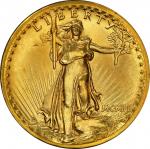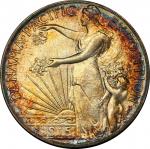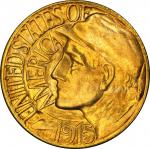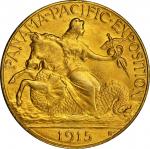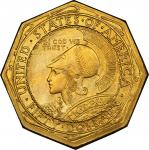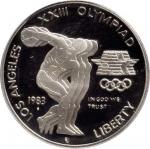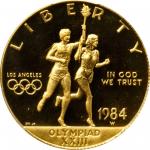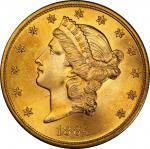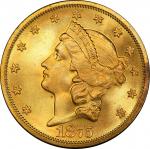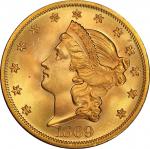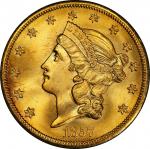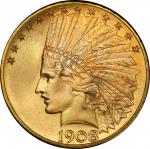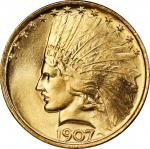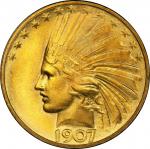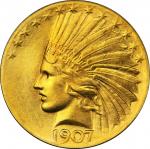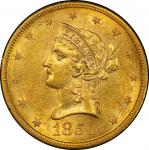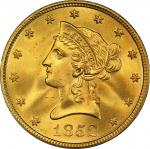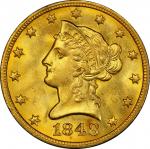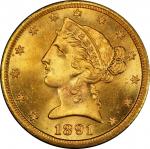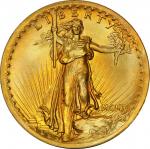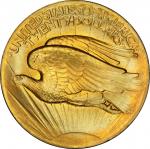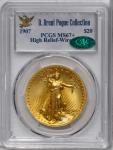MCMVII (1907) Saint-Gaudens Double Eagle. High Relief. Wire Rim. MS-67+ (PCGS). CAC. This virtually pristine coin presents intense mint luster on predominantly medium gold surfaces. Rose-gold highlights are also evident on both sides under a light - very attractive. Fully struck, as befits the issue, with a beautiful appearance that will delight gold enthusiasts as well as advanced type collectors.The High Relief Saint-Gaudens double eagle is one of those coins that appear on most numismatists wish lists even if twentieth century American gold is not a chosen field of study. The image of Liberty striding towards the viewer holding a torch and olive branch is one of the most familiar coin motifs and is recognizable by even those with the most casual interest in coins.The MCMVII High Relief double eagle has long been celebrated as one of the most beautiful coin designs in all of American numismatics. The story of its creation and the partnership between president and sculptor adds to the appeal of the novel design. In 1905, President Teddy Roosevelt, arguably the president who took the most active and personal interest in our coinage designs, was sadly disappointed with the mediocre appearance of Americas coinage designs of the era. The president had only recently taken an interest in ancient Greek coins, having just seen some on display, and he vocally lamented the fact that the coinage of his "bully pulpit" era was mainly plain and uninspired in comparison to those ancient works of numismatic art. Accordingly, Roosevelt contracted with his long time acquaintance, Augustus Saint-Gaudens, paying the sum of $5,000 to him to redesign the entire U.S. coinage spectrum, from the small bronze cent all the way up the denominational ladder to the large gold double eagle. Saint-Gaudens, Americas most admired sculptor, kept his studio and family home in Cornish, New Hampshire, where he prepared the many sketches and working models for his ideas. By the summer of 1907, Saint-Gaudens had nearly completed the work on the Indian $10 design as well as the new $20 design (which was based on his statue of Victory, part of the Sherman Victory Monument which stands proudly today in New York Citys Central Park). On August 3, 1907, Saint-Gaudens succumbed to cancer without having seen an example of his work in its legal tender form; his stunning design was finished by his assistant, Henry Hering. Meanwhile, a great "war" of words and bombast (Roosevelt called it his "pet crime") had broken out between the Mint and Charles Barber on one side, and the "Ol Rough Rider," President Roosevelt, on the other. Barber was gravely upset that Roosevelt had unkind words for his dime, quarter, and half dollar designs (which had circulated as current coin of the realm since 1892), and he was also incensed over the fact that an outside artist had been chosen to redesign our countrys coinage. Further, Barber protested that the high relief of the dies would prevent the coins from striking, stacking at banks, and on and on, causing Roosevelt to state that the MCMVII $20 coins would be produced if it took all day to strike just one coin!Despite Barbers shenanigans, the MCMVII High Relief double eagles were eventually produced to the tune of several hundred pieces a day, though not without difficulties - each coin needed three blows from the dies to be rendered to its full design advantage. In time, however, some 11,250 High Relief MCMVII double eagles were produced to the presidents satisfaction. Barber then redesigned the dies, making them flatter in depth and considerably less dynamic in appearance, and swapping the Roman numerals for Arabic. This style would continue through the demise of the series in 1933. From the D. Brent Pogue Collection.

